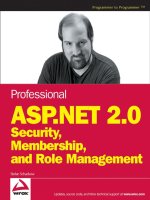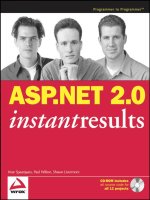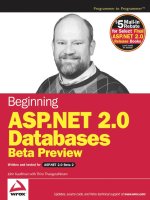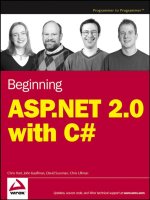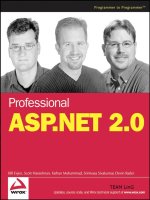professional asp.net 2.0 server control and component development
Bạn đang xem bản rút gọn của tài liệu. Xem và tải ngay bản đầy đủ của tài liệu tại đây (16.53 MB, 1,227 trang )
Professional
ASP.NET 2.0 Server Control and
Component Development
Dr. Shahram Khosravi
01_793507 ffirs.qxp 7/10/06 5:21 PM Page iii
01_793507 ffirs.qxp 7/10/06 5:21 PM Page ii
Professional
ASP.NET 2.0 Server Control and
Component Development
01_793507 ffirs.qxp 7/10/06 5:21 PM Page i
01_793507 ffirs.qxp 7/10/06 5:21 PM Page ii
Professional
ASP.NET 2.0 Server Control and
Component Development
Dr. Shahram Khosravi
01_793507 ffirs.qxp 7/10/06 5:21 PM Page iii
Professional ASP.NET 2.0 Server Control and Component
Development
Published by
10475 Crosspoint Boulevard
Indianapolis, IN 46256
www.wiley.com
Copyright © 2006 by Wiley Publishing, Inc., Indianapolis, Indiana
Published simultaneously in Canada
ISBN-13: 978-0-471-79350-2
ISBN-10: 0-471-79350-7
Manufactured in the United States of America
10 9 8 7 6 5 4 3 2 1
1MA/RZ/QX/QW/IN
Library of Congress Cataloging-in-Publication Data is available from the Publisher.
No part of this publication may be reproduced, stored in a retrieval system or transmitted in any form or by
any means, electronic, mechanical, photocopying, recording, scanning or otherwise, except as permitted under
Sections 107 or 108 of the 1976 United States Copyright Act, without either the prior written permission of the
Publisher, or authorization through payment of the appropriate per-copy fee to the Copyright Clearance Cen-
ter, 222 Rosewood Drive, Danvers, MA 01923, (978) 750-8400, fax (978) 646-8600. Requests to the Publisher for
permission should be addressed to the Legal Department, Wiley Publishing, Inc., 10475 Crosspoint Blvd., Indi-
anapolis, IN 46256, (317) 572-3447, fax (317) 572-4355, or online at />LIMIT OF LIABILITY/DISCLAIMER OF WARRANTY: THE PUBLISHER AND THE AUTHOR MAKE NO
REPRESENTATIONS OR WARRANTIES WITH RESPECT TO THE ACCURACY OR COMPLETENESS OF
THE CONTENTS OF THIS WORK AND SPECIFICALLY DISCLAIM ALL WARRANTIES, INCLUDING
WITHOUT LIMITATION WARRANTIES OF FITNESS FOR A PARTICULAR PURPOSE. NO WARRANTY
MAY BE CREATED OR EXTENDED BY SALES OR PROMOTIONAL MATERIALS. THE ADVICE AND
STRATEGIES CONTAINED HEREIN MAY NOT BE SUITABLE FOR EVERY SITUATION. THIS WORK IS
SOLD WITH THE UNDERSTANDING THAT THE PUBLISHER IS NOT ENGAGED IN RENDERING
LEGAL, ACCOUNTING, OR OTHER PROFESSIONAL SERVICES. IF PROFESSIONAL ASSISTANCE IS
REQUIRED, THE SERVICES OF A COMPETENT PROFESSIONAL PERSON SHOULD BE SOUGHT.
NEITHER THE PUBLISHER NOR THE AUTHOR SHALL BE LIABLE FOR DAMAGES ARISING HERE-
FROM. THE FACT THAT AN ORGANIZATION OR WEBSITE IS REFERRED TO IN THIS WORK AS ACITA-
TION AND/OR A POTENTIAL SOURCE OF FURTHER INFORMATION DOES NOT MEAN THAT THE
AUTHOR OR THE PUBLISHER ENDORSES THE INFORMATION THE ORGANIZATION OR WEBSITE
MAY PROVIDE OR RECOMMENDATIONS IT MAY MAKE. FURTHER, READERS SHOULD BE AWARE
THAT INTERNET WEBSITES LISTED IN THIS WORK MAY HAVE CHANGED OR DISAPPEARED
BETWEEN WHEN THIS WORK WAS WRITTEN AND WHEN IT IS READ.
For general information on our other products and services please contact our Customer Care Department
within the United States at (800) 762-2974, outside the United States at (317) 572-3993 or fax (317) 572-4002.
Wiley, the Wiley logo, Wrox, the Wrox logo, Programmer to Programmer, and related trade
dress are trademarks or registered trademarks of John Wiley & Sons, Inc. and/or its affiliates, in the United
States and other countries, and may not be used without written permission. All other trademarks are the
property of their respective owners. Wiley Publishing, Inc., is not associated with any product or vendor
mentioned in this book.
Wiley also publishes its books in a variety of electronic formats. Some content that appears in print may not
be available in electronic books.
01_793507 ffirs.qxp 7/10/06 5:21 PM Page iv
About the Author
Shahram Khosravi
Shahram Khosravi started working as a software engineer while still in college. After completing his
Ph.D., he continued working on cutting-edge software development projects. Shahram is a senior soft-
ware engineer, consultant, author, and instructor specializing in ASP.NET, Web services, .NET technologies,
XML technologies, ADO.NET, C#, 3D computer graphics, Human Interface (HI) usability, and design pat-
terns. He has more than 10 years of experience in object-oriented analysis, design, and programming.
Shahram has written articles on the .NET Framework, ADO.NET, ASP.NET, and XML technologies for
industry leading magazines such as Dr. Dobb’s Journal, asp.netPRO magazine, and Microsoft MSDN
Online. He is a great enthusiast for using, teaching, and writing about the latest Microsoft technologies,
and provides consulting and training services to help others use them in their own software products.
01_793507 ffirs.qxp 7/10/06 5:21 PM Page v
01_793507 ffirs.qxp 7/10/06 5:21 PM Page vi
Credits
Senior Acquisitions Editor
Jim Minatel
Development Editor
Brian MacDonald
Technical Editor
Scott Spradlin
Production Editor
Felicia Robinson
Copy Editor
Kim Cofer
Editorial Manager
Mary Beth Wakefield
Production Manager
Tim Tate
Vice President and Executive Group Publisher
Richard Swadley
Vice President and Executive Publisher
Joseph B. Wikert
Graphics and Production Specialists
Jennifer Click
Brooke Graczyk
Denny Hager
Barbara Moore
Barry Offringa
Lynsey Osborn
Alicia B. South
Julie Trippetti
Quality Control Technicians
John Greenough
Leeann Harney
Jessica Kramer
Christy Pingleton
Rob Springer
Brian H. Walls
Proofreading and Indexing
Techbooks
01_793507 ffirs.qxp 7/10/06 5:21 PM Page vii
Acknowledgments
I would first like to thank Jim Minatel, the senior acquisitions editor on the book or giving me the oppor-
tunity to write this exciting book. Huge thanks go to Brian MacDonald, the book’s development editor.
Thanks for all your valuable input, comments, and suggestions. I’ve really enjoyed working with you on
this wonderful project. I’d also like to thank Scott Spradlin, the book’s technical editor, for his work.
Thanks for your valuable input. Thanks also go to Felicia Robinson, the book’s production editor.
Additional thanks go to (Kim Cofer, the copy editor and Techbooks, the proofreader). I would also like
to thank my friends for understanding my absence.
01_793507 ffirs.qxp 7/10/06 5:21 PM Page viii
Contents
Acknowledgments viii
Introduction xxi
Chapter 1: The ASP.NET 2.0 Framework 1
Following the Request 1
Why Develop Custom Components? 5
Data Source Controls 6
Role Manager Modules and Principals 6
Role Providers 7
Membership Providers 7
Customizing XML Web Services and Their Clients 7
Developing Ajax-Enabled Controls and Components 7
Developing Web Parts Controls 8
Developing Custom Data Control Fields 8
Developing Custom HTTP Handlers and Modules 9
Developing Custom Provider-Based Services 9
Summary 9
Chapter 2: Developing Simple Custom Controls and User Controls 11
Information Hiding 12
Deploying Your Custom Controls 16
Using Custom Controls in a Web Page 17
Adding Properties to Your Custom Controls 18
Adding Design-Time Attributes to Your Custom Controls 20
Property-Level Attributes 20
Class-Level Attributes 21
Assembly-Level Attributes 22
Adding Your Custom Control to the Visual Studio Toolbox 23
The HtmlTextWriter-Related Enumerations 23
State Management 28
User Controls 32
Using a User Control 33
Adding Properties to User Controls 34
Adding Methods to User Controls 36
Under the Hood 38
Summary 39
02_793507 ftoc.qxp 6/29/06 7:20 PM Page ix
x
Contents
Chapter 3: Developing Custom-Styled Controls 41
Style 41
WebControl 43
Overriding the Render Method 47
TagKey 47
RenderBeginTag 48
AddAttributesToRender 48
RenderContents 52
RenderEndTag 52
Deriving from the WebControl Class 53
Developing a Custom Style Class 58
Using Your Custom Style Class 62
Summary 64
Chapter 4: Developing Custom Controls That Raise Events 65
About Events 65
.NET Event Design Pattern 66
Event Data and Event Delegate Class 66
Enabling Your Custom Control to Raise the Event 69
Event Optimization 70
Postback 73
C# Interface Implementation Pattern 75
Postback Event 76
Postback Data 77
Page Life Cycle 86
Summary 90
Chapter 5: Developing Custom Composite Controls 91
CreditCardForm6 Revisited 91
Rendering HTML 92
Postback Functionality 95
Creating Composite Controls 97
Deriving from CompositeControl 98
Choosing the Child Controls 98
Choosing the Layout 99
Implementing a Custom Container Control 100
Creating a Container Control 101
Creating the Child Controls of a Container Control 102
Applying Style to a Container Control 105
Adding a Container Control to a Composite Control 105
Rendering a Container Control 106
02_793507 ftoc.qxp 6/29/06 7:20 PM Page x
xi
Contents
CreateChildControls: One-Stop Shopping for All Your Child Controls 106
TagKey 108
CreateControlStyle 109
Exposing Style Properties 109
RenderContents 109
Label Properties 112
Event Bubbling 114
What Your Custom Control Inherits from CompositeControl 117
Overriding the Controls Collection 118
INamingContainer Interface 118
Summary 120
Chapter 6: Developing Custom Templated Controls 121
Customizing the Contents of a Container Control 121
TemplatedCreditCardForm 124
Using the Template in an ASP.NET Page 125
Under the Hood of the Template 127
Data Binding Expressions 130
Under the Hood of Data Binding Expressions 135
Default Template 137
Summary 145
Chapter 7: Developing Custom Controls with Complex Properties 147
Container Control Style Properties 147
Customizing the Appearance of a Container Control 148
State Management 151
Types That Implement IStateManager 152
DefaultTemplateManager 154
TemplatedCreditCardForm3 158
Types That Don’t Implement IStateManager 164
TypeConverter 164
DefaultTemplateManager2 165
DefaultTemplateManager2Converter 166
Marking DefaultTemplateManager2 with Its Converter 168
Using the Non-IStateManager Class 169
Why You Need to Use TypeDescriptor 172
State Management of Container Control Styles 172
Property Declaration 173
TrackViewState 174
SaveViewState 175
LoadViewState 176
02_793507 ftoc.qxp 6/29/06 7:20 PM Page xi
xii
Contents
Declarative Persistence 177
Simple Properties 177
Complex Properties (Hyphenated Declarative Persistence) 177
Complex Properties (Inner-Property Declarative Persistence) 179
Summary 181
Chapter 8: ASP.NET Request Processing Architecture 183
Following the Request 183
HTTP Modules 187
HTTP Handlers 188
HTTP Handler Factories 189
Control Builders 189
Developing Custom HTTP Modules 196
Registering Your Custom HTTP Module 198
Developing Custom HTTP Handler Factories 199
Developing Custom HTTP Handlers 200
RSS 201
RssHandler 202
Registering Your Custom HTTP Handler 205
Developing Custom Control Builders 207
Developing the CompositeCreditCardForm2Builder Custom Control Builder 210
Developing the CompositeCreditCardForm2 Custom Control 210
Summary 216
Chapter 9: Data Binding 217
The CustomTable Control 217
Specifying the Data Source 218
Overriding CreateChildControls 220
Overriding the DataBind Method 221
Creating the Control Hierarchy 222
DataControlField 225
CreateFields 225
CreateHeaderRow 227
CreateBodyRow 228
CachePrimaryKey 233
CreatePagerRow 234
Overriding CreateControlStyle 235
Implementing the CustomTable Events 235
Overriding OnBubbleEvent 237
CustomTableRow 238
02_793507 ftoc.qxp 6/29/06 7:20 PM Page xii
xiii
Contents
CustomTableRowCollection 240
Child Control Styles 240
Overriding Render 241
State Management 243
TrackViewState 243
SaveViewState 244
LoadViewState 245
Using CustomTable in a Page 246
Shortcomings of the CustomTable Control 247
Summary 248
Chapter 10: XML Web Services 249
Developing and Consuming an XML Web Service 250
Under the Hood of the Add Reference Button 252
WSDL Document 255
The Names, Types, and Order of the Arguments 257
The Types and Order of the Return Values 257
Describing the Method 258
Describing the Communication Protocol for Accessing the Method 259
Specifying the Site for Method Access 260
Specifying the Class of the Method 260
The XmlWebServiceMethodInvoker Class 260
Programmatically Downloading the WSDL Document 261
De-serializing a .NET Object from the WSDL Document 262
Generating the Code for the Proxy Class 263
Under the Hood of the Import Method 263
Compiling the Code for the Proxy Class 267
Creating an Instance of the Proxy Class 268
Invoking the Specified Method of the Proxy Class Instance 268
Putting It All Together: The InvokeXmlWebServiceMethod Method 272
How to Use XmlWebServiceMethodInvoker 272
Caching the Compiled Proxy Class 275
Cache-Related Properties 275
CompileCodeForProxyClass 276
InvokeXmlWebServiceMethod 277
Using the Caching Feature 278
Developing XML Web Service–Enabled Custom Controls 281
XmlWebServiceResolver 283
XMLResolver 283
GetEntity 288
Summary 291
02_793507 ftoc.qxp 6/29/06 7:20 PM Page xiii
xiv
Contents
Chapter 11: Implementing Schema Importer Extensions and ISerializable
Interface 293
Implementing IXmlSerializable 293
Implementing the Server-Side Component 294
Developing the Client-Side Component 299
Developing Custom Schema Importer Extensions 301
Write the Code in Your Favorite Language 303
CodeDom Approach 304
Registering Your Custom Schema Importer Extension 317
Sending and Receiving Data in Chunks 318
BookContent 319
ForumBook 321
Custom Schema Importer Extension 322
Extensibility of the XmlWebServiceMethodInvoker 324
Summary 324
Chapter 12: Understanding the ASP.NET 2.0 Tabular Data Source
Control Model 325
Why You Need the ASP.NET 2.0 Data Source Control Model 325
Retrieving Data 327
Update Event 328
The ASP.NET 2.0 Data Source Control Model 330
ASP.NET 2.0 Tabular Data Source Control Model 331
IDataSource 332
Under the Hood of DataSourceControl 333
Deriving from the DataSourceControl Base Class 335
DataSourceView 336
Delete 347
Update 351
Insert 355
State Management 359
Summary 360
Chapter 13: The ASP.NET 2.0 Data Source Control Parameter Model 361
Parameters 361
The Parameter Class 365
The OnParameterChanged Method 365
SaveCurrentValue Method 366
Evaluate Method 366
CookieParameter 367
ControlParameter 368
02_793507 ftoc.qxp 6/29/06 7:20 PM Page xiv
xv
Contents
ParameterCollection 370
ParametersChanged Event 370
OnInsert Method 371
GetValues Method 371
UpdateValues Method 372
Automatic Invocation of GetValues and UpdateValues Methods 373
Properties of Type ParameterCollection 373
OnInit and Page_LoadComplete Methods 375
ExecuteSelect 375
ExecuteDelete 376
ExecuteUpdate 378
ExecuteInsert 379
Putting It All Together 381
Developing Custom Parameters 383
XmlWebServiceParameter 383
ObjectParameter 387
ClientParameter 390
Summary 394
Chapter 14: Developing ASP.NET 2.0 Custom Tabular Data Source Controls 395
The XmlWebServiceMethodInvoker Component 396
DataSourceControl 398
DataSourceView 399
ExecuteSelect 399
ExecuteUpdate 411
ExecuteInsert 416
ExecuteDelete 420
RetrieveMethodArgumentNamesAndValues 423
State Management 426
Summary 428
Chapter 15: Understanding the ASP.NET 2.0 Hierarchical Data
Source Control Model 429
IHierarchicalDataSource 430
HierarchicalDataSourceControl 431
HierarchicalDataSourceView 433
IHierarchyData 436
IHierarchicalEnumerable 437
XmlHierarchyData 440
XmlHierarchicalEnumerable 446
XmlHierarchyDataPropertyDescriptor 447
02_793507 ftoc.qxp 6/29/06 7:20 PM Page xv
xvi
Contents
ICustomTypeDescriptor 450
XmlHierarchicalDataSourceView 451
Summary 452
Chapter 16: Developing ASP.NET 2.0 Custom Hierarchical
Data Source Controls 453
CustomSqlDataSource 453
SqlHierarchyDataPropertyDescriptor 459
SqlHierarchyData 462
Constructor 462
Implementing HasChildren 463
Implementing the Type Property 463
SqlHierarchicalEnumerable 465
SqlHierarchicalDataSourceView 467
Summary 468
Chapter 17: Understanding the ASP.NET 2.0 Tabular
Data-Bound Control Model 469
The Big Picture 470
ASP.NET 1.x Data-Bound Control Model 471
The RetrieveData Method 472
Overriding the DataBind Method 472
Handling the Third Data-Binding Task 472
BaseDataBoundControl 473
Automating the Invocation of the DataBind Method 473
The First and Second Data-Binding Tasks 474
The Third Data-Binding Task 475
Developing Custom Data-Bound Controls That Derive from BaseDataBoundControl 476
Handling the Load Event 477
Overriding the PerformSelect Method 477
Declarative Programming Without Writing Code 479
Shortcomings of the CustomTable2 Control 480
DataBoundControl 480
The GetDataSource Method 482
The GetData Method 482
Overriding the Abstract Methods of the BaseDataBoundControl 483
Developing Custom Data-Bound Controls That Derive from DataBoundControl 486
Overriding the CreateDataSourceSelectArguments Method 486
Overriding the PerformDataBinding Method 488
The UpdateCallback Method 489
02_793507 ftoc.qxp 6/29/06 7:20 PM Page xvi
xvii
Contents
The DeleteCallback Method 490
Codeless Data-Agnostic Declarative Programming 491
CompositeDataBoundControl 492
Overriding the PerformDataBinding Method 494
Overriding the DataBind Method 494
Overriding the CreateChildControls Method 495
Overriding the Controls Collection 495
Developing Controls That Derive from CompositeDataBoundControl 496
MasterDetailForm 496
AddDetailRow 501
AddMasterCell 503
AddMasterHeaderCell 504
AddMasterSelectButton 504
AddDetailCommandBar 505
Delete Data Operation 507
Update Data Operation 508
Sort Data Operation 509
Control State 510
Appearance Properties 511
Codeless Master/Detail Form 512
Summary 513
Chapter 18: The ASP.NET 2.0 Data Control Field Model 515
Why You Need the ASP.NET 2.0 Data Control Field Model 515
DataControlField 518
The OnFieldChanged Method 519
Initialize Method 520
InitializeCell Method 520
ExtractValuesFromCell Method 521
BoundField 522
InitializeCell 523
InitializeDataCell 523
OnDataBindField 524
GetValue 525
ExtractValuesFromCell 526
DataControlFieldCollection 527
FieldsChanged Event 528
OnInsert Method 528
Developing Custom Data Control Fields 529
DropDownListField 529
CalendarField 537
Summary 542
02_793507 ftoc.qxp 6/29/06 7:20 PM Page xvii
xviii
Contents
Chapter 19: Developing ASP.NET 2.0 Custom Tabular Data-Bound Controls 543
Deriving from the CompositeDataBoundControl 544
Overriding the CreateChildControls Method 545
Initializing the Parameters 546
Describing the Primary Key Fields 547
Creating the Child Table Control 548
Creating the PagedDataSource Object 549
Creating the Data Control Fields 551
Creating the Top Pager Row 555
Creating the Header Row 558
Enumerating the Data Records 558
Creating the Empty Data Row 560
Creating and Populating the GridViewRowCollection 561
The CreateRow Method 562
The InitializeRow Method 562
Overriding the CreateDataSourceSelectArguments Method 564
Overriding the CreateControlStyle Method 565
Overriding the OnBubbleEvent Method 565
The EventHandler Method 566
Overriding the Render Method 573
State Management 576
Overriding the OnInit Method 578
Events 578
GridViewRow 581
GridViewRowCollection 585
Summary 585
Chapter 20: Why You Need the ASP.NET 2.0 Membership/Role Model 587
ASP.NET 1.x Security Model 588
Authorization Mechanisms 593
Shortcomings of the ASP.NET 1.x Security Model 594
The .NET 2.0 Provider Pattern 595
Summary 597
Chapter 21: Understanding the ASP.NET 2.0 Membership Model 599
Membership 599
Membership Provider Instantiation and Initialization 600
Support for the <membership> Section 600
Provider and Providers Properties 602
02_793507 ftoc.qxp 6/29/06 7:20 PM Page xviii
xix
Contents
Membership API 605
Adding a New User to the Data Store 605
Removing a User from the Data Store 607
Updating Specified User Membership Information in the Data Store 607
Validating User Credentials Against the Data Store 607
Searching Users in the Data Store 608
Retrieving User Membership Information from the Data Store 609
Enforcing Application-Specific Password Validation Rules 610
Accessing the User Online Time Window 612
Developing Custom Security Controls 613
Login 613
Register 618
Using the Login and Register Controls 619
Registering the SqlMembershipProvider 621
MembershipUser 622
Accessing the Membership Provider 624
Resetting and Retrieving Passwords 624
Changing Passwords 625
Changing Password Question and Answer 625
Unlocking a User 626
Summary 626
Chapter 22: Developing Custom MembershipProvider and MembershipUser
Components 627
MembershipProvider 628
SqlMembershipProvider 629
ProviderBase 629
MembershipProvider 635
ChangePassword 635
ValidateUserInfo 637
UpdateUserInfo 641
Update 642
ChangePasswordQuestionAndAnswer 642
CreateUser 643
DeleteUser 648
FindUsersByEmail 648
FindUsersByName 650
GetAllUsers 651
Select 653
GetNumberOfUsersOnline 653
GetPassword 653
GetUser 656
GetUserNameByEmail 658
02_793507 ftoc.qxp 6/29/06 7:20 PM Page xix
xx
Contents
ResetPassword 659
UnlockUser 661
UpdateUser 662
ValidateUser 662
Registering SqlMembershipProvider 662
Using the Custom Membership Provider 663
Extending the ASP.NET 2.0 Membership API 665
CustomMembershipUser 666
CustomMembershipProvider 667
CustomSqlMembershipProvider 667
Using CustomMembershipUser, CustomMembershipProvider, and
CustomSqlMembershipProvider 673
Summary 675
Chapter 23: Understanding the ASP.NET Role Management Model 677
Roles API 678
Managing Roles 678
Managing Users 679
RolePrincipal 681
Identity 681
Role Membership 682
IPrincipal 682
RoleManagerModule 687
PostAuthenticateRequestCallback 687
GetRoles Event 689
EndRequestCallback 690
Summary 692
Chapter 24: Developing Custom Role Providers, Modules, and Principals 693
RoleProvider 693
XmlRoleProvider 694
ProviderBase 695
XML APIs 696
Streaming XML APIs 696
Random-Access XML APIs 701
Implementing RoleProvider’s Methods 703
LoadData 704
SaveData 704
Role Management 705
User Management 716
02_793507 ftoc.qxp 6/29/06 7:20 PM Page xx
xxi
Contents
Developing Custom Role Principals 727
Constructors 728
GetRoles 730
Implementing the IPrincipal Interface 731
Developing Custom Role Manager Modules 732
PostAuthenticateRequestCallback 733
GetRoles Event 735
EndRequestCallback 736
XmlRoleProvider and CacheDependency 738
Using the XmlRoleProvider 739
Summary 743
Chapter 25: Developing Custom Provider-Based Services 745
Recipe for Developing Custom Provider-Based Services 745
Provider-Based RSS Service 746
Custom Provider Base 747
Custom Provider Collection 748
Configuring the Web.config and Machine.config Files 748
Custom Configuration Section 749
Registering the <rssService> Section 750
Implementing the Service Class 750
Using the RSS Service 753
SqlRssProvider 753
Initialize 754
LoadRss 759
GetDataReader 761
Registering SqlRssProvider 761
RssHelper 762
XmlRssProvider 764
Initialize 764
LoadRss 767
RetrieveData 769
Registering XmlRssProvider 770
Summary 771
Chapter 26: Developing Ajax-Enabled Controls and Components:
Client-Side Functionality 773
Ajax-Enabled Controls and Components 774
Recipe for Implementing Ajax-Enabled Controls’ Client-Side Functionality 776
02_793507 ftoc.qxp 6/29/06 7:20 PM Page xxi
xxii
Contents
Rendering Options 776
Rendering Client Script as HTML Attribute Values 776
Rendering Client Script as Script Blocks 779
Client Script Library 786
Deployment Issues 789
Deploying Resource Files to a Shared Location 789
Embedding Resource Files into an Assembly 790
When to Render Your Control’s Client Script 798
Disabling Your Control’s Client-Side Capabilities 798
Discovering Ajax Capabilities of the Requesting Browser 798
Where to Render Your Control’s Client Script 800
Overriding OnPreRender 800
Overriding AddAttributesToRender 800
Overriding RenderContents 801
Overriding Render 801
Falling Back on Server-Side Code 801
Developing Ajax-Enabled Controls 802
CustomImage Ajax-Enabled Control 804
ImageDialog Ajax-Enabled Composite Control 811
Summary 825
Chapter 27: Developing Ajax-Enabled Controls and Components:
Asynchronous Client Callback 827
Motivation for the AjaxDropDownList Control 828
The Client Callback Mechanism 829
Implementing the ASP.NET 2.0 Client Callback Mechanism 830
Overriding the OnPreRender Method 831
Overriding the Render Method 837
Server Side 838
The ASP.NET 2.0 Client Callback Mechanism 839
Overriding the OnPreRender Method 840
Overriding the Render Method 841
Server Side 842
Data Store-Agnostic Ajax-Enabled Controls 844
Master/Detail Form 847
Developing Ajax-Enabled Data Control Fields 848
AjaxDetailsDialog 851
AjaxDetailsDialog as a Composite Control 854
AjaxDetailsDialog as an Ajax-Enabled Control 857
AjaxField Data Control Field 864
Overriding InitializeCell 865
Overriding OnDataBindField 868
02_793507 ftoc.qxp 6/29/06 7:20 PM Page xxii
